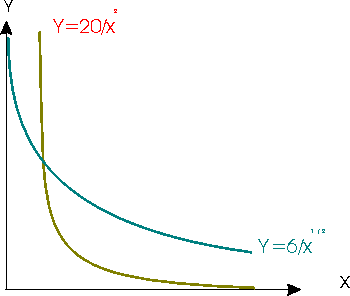Econ 302: Solutions for Practice Questions 1
Question 1:
- f(x)=x2/(1+4x). Use the quotient
rule. Thus, g(x)=x2, h(x)=1+4x, g '(x)=2x, and
h '(x)=4.
This implies
f '(x)=[2x(1+4x)-4x2] / (1+4x)2 = [2x+4x2] / (1+4x)2. - f(x)=ln(x+20). Use the chain rule. g(x)=ln (x) and h(x)=x+20. Since h '(x)=1 because of additivity, it follows that f '(x)=1/(x+20).
- f(x)=ln(x+a). Same as above. Only difference h(x)=x+a. Again, additivity, implies h '(x)=1. Thus, f '(x)=1/(x+a).
- f(x)=(x2+5)1/2. Again use the chain rule, choosing g(x)=x1/2 and h(x)=4+x4. The derivatives are g '(x)=(1/2)x-1/2 and h '(x)=4x3 (because of additivity the number 4 drops out). Thus, f '(x)=(1/2)(4+x4)-1/24x3 = 2x3 / (4+x4)1/2.
- f(x)=(a+x4)1/2. The only difference to the previous question is that now h(x)=a+x4. Again because of additivity a drops out, since it is a fixed number. The answer is therefore f '(x) = 2x3 / (a+x4)1/2.
- f(x)=3x2+6x4. Because of additivity f '(x) is the sum of the derivative of 3x2 and of 6x4. Thus, f '(x)=6x+24x3.
- Because of linearity the derivative of ax2 is 2ax and of bx4 is 4bx3. Thus, f '(x)=2ax+4bx3.
Question 2:
- f(x,y)=xy3. Derivative with respect to x: Now y (and thus y3) is treated like a constant. Thus, linearity implies fx=y3. Similarly fy=3xy2.
- f(x,y)=x+20y. To take the derivative with respect to x, y is treated like a constant. Thus, we have essentially an expression of the form x+a, where a is fixed. Thus, additivity implies fx=1. Similarly, it follows that fy=20.
- Same idea as above, i.e., one of the summands is a constant when taking the partial derivative. Thus fx=10/x and fy=1/y.
- Use the quotient rule. g(x,y)=x+2y, h(x,y)=y. The partials are gx=1, gy=2, hy=1 and hx=0. Thus, fx=1/y and fy = (2y-x+2y)/y2= -x/y2.
- f(x,y)=2x2+y. Again, additivity implies fx=4x and fy=1.
- f(x,y)=ax2+by. Now additivity and the rule of multiplication with scalars implies fx=2ax and fy=b.
Question 3:
- x2y=20 immediately implies y=20/x2.
- The slope is given by the derivative of
20/x2 at x=2.
The derivative of 20/x2 is -40/x3. Thus, if x=2 we get -40/8=-5. -
The value of y is 5 at x=2.

- y2=36/x. Thus, y=6/x1/2 (recall that x1/2 is the square root of x).
- The slope is given by the derivative of
6/x1/2 at x=4.
The derivative is -3/x-3/2. Thus, if x=4 we get -3/8. - y=3 at x=4.